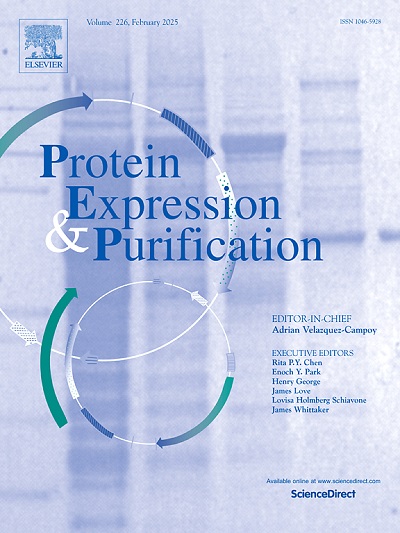精氨酸添加对超滤蛋白浓度的影响。
IF 1.2
4区 生物学
Q4 BIOCHEMICAL RESEARCH METHODS
引用次数: 0
摘要
在本研究中,我们研究了精氨酸(L-ArgHCl)对超滤性能的影响,这一过程不仅具有研究意义,而且具有制药应用意义。具体来说,我们使用兔和山羊多克隆抗体(中性至碱性等电点)以及模型蛋白、BSA(酸性)和溶菌酶(碱性)来评估超滤的产率和滤过率。将1 mg/mL的蛋白质溶液用标准的离心超滤装置浓缩约10倍后,在接近中性的缓冲ph下,L-ArgHCl的加入显著提高了收率。观察到的提高顺序为:20 mM L-ArgHCl > 100 mM L-ArgHCl≈0.5 M NaCl >不添加。在100 mM L-ArgHCl条件下,溶菌酶的产量略高。在1 mg/mL兔多克隆抗体的40倍浓度下,20 mM L-ArgHCl在pH为6和7时提高了产量,但在pH为7.5时影响很小或没有影响。值得注意的是,在pH为8时,不需要精氨酸就可以获得高产量。L-ArgHCl也加速了所有pH水平下的浓度速率,在较高的精氨酸浓度下观察到更大的增强。这些发现表明L-ArgHCl通过减少蛋白质相互作用和与超滤膜的非特异性结合来减轻蛋白质沉淀和溶解度损失。在pH为8时,抗体表面电荷的增加降低了疏水性,进一步提高了溶解度。综上所述,L-ArgHCl的加入,特别是pH值接近7时,有效地增强了超滤性能。这为改善蛋白质浓缩过程提供了一种实用的策略。本文章由计算机程序翻译,如有差异,请以英文原文为准。
Impact of arginine addition on protein concentration via ultrafiltration
In this study, we examined the effects of arginine (L-ArgHCl) on ultrafiltration performance, a process with practical significance for not only research but also pharmaceutical applications. Specifically, we assessed the yield and filtration rate of ultrafiltration using rabbit and goat polyclonal antibodies (neutral to basic isoelectric points) as well as model proteins, BSA (acidic) and lysozyme (basic). When a 1 mg/mL protein solution was concentrated approximately 10-fold using a standard commercially available centrifugal ultrafiltration device, the addition of L-ArgHCl significantly improved yield at near-neutral buffer pH. The observed order of improvement was: 20 mM L-ArgHCl >100 mM L-ArgHCl ≈0.5 M NaCl > no addition. A similar trend was observed with BSA, whereas lysozyme achieved slightly higher yields at 100 mM L-ArgHCl. In a 40-fold concentration of rabbit polyclonal antibody from 1 mg/mL, 20 mM L-ArgHCl enhanced yield at pH 6 and 7, but had minimal or no effect at pH 7.5. Notably, at pH 8, high yields were achieved without arginine. L-ArgHCl also accelerated the concentration rate at all pH levels, with greater enhancements observed at higher arginine concentrations. These findings suggest that L-ArgHCl mitigates protein precipitation and solubility loss by reducing protein-protein interactions and nonspecific binding to the ultrafiltration membrane. At pH 8, the increased surface charge of the antibody reduced hydrophobicity, further improving solubility. In summary, the addition of L-ArgHCl, particularly near pH 7, effectively enhanced ultrafiltration performance. This provides a practical strategy for improving protein concentration processes.
求助全文
通过发布文献求助,成功后即可免费获取论文全文。
去求助
来源期刊

Protein expression and purification
生物-生化研究方法
CiteScore
3.70
自引率
6.20%
发文量
120
审稿时长
32 days
期刊介绍:
Protein Expression and Purification is an international journal providing a forum for the dissemination of new information on protein expression, extraction, purification, characterization, and/or applications using conventional biochemical and/or modern molecular biological approaches and methods, which are of broad interest to the field. The journal does not typically publish repetitive examples of protein expression and purification involving standard, well-established, methods. However, exceptions might include studies on important and/or difficult to express and/or purify proteins and/or studies that include extensive protein characterization, which provide new, previously unpublished information.
 求助内容:
求助内容: 应助结果提醒方式:
应助结果提醒方式:


